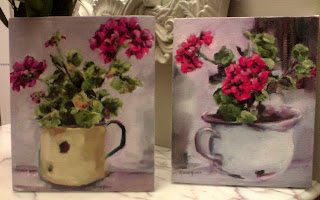+50+x+40+cm.jpg)
Few people embrace themes as tenaciously as Jeanette - suffice it to say that on receiving details
about 'Renaissance - Recalling the Age of Antiquity', she set to work immediately to find out specific historic details about the church depicted in her oil painting shown here
' Positano' (500mm x 400mm)
and sent me this very interesting piece....
The church of Santa Maria Assunta is famous for its magnificent dome of Majolica tiles, which dominates the village. 'Harpaars Bazaar' was the first movie which portrayed Positano to the outside world, and since then many movies (under Tuscan Sky) have been made in this beautiful setting along the famous Amalfi Coast of Italy.
The village is said to get its name from an incident when pirates stole a 13th C Icon of a Black Madonna from Byzantium. There was a terrible storm off Positano and the sailors heard a voice saying, 'Posa Posa (put down)'. They unloaded the Icon and the storm abated. Santa Maria Assunta was later built around the Icon.
The other painting to be exhibited is entitled 'Girl picking Poppies' (600mm x 750mm)which was inspired by Monet's "Poppies at Argentuil'.
To quote Jeannette -Monet portrayed the simple pleasures of life, like walking through fields of flowers on a sunny day - that is what I hoped to capture.....
and indeed she has!!!....somehow though, this did lead me onto thinking of another aspect...lest we forget...
November is poppy month, the time of the year when by the wearing of a simple emblem, a red poppy, we salute the memory of those who sacrificed their health, their strength, even their lives, that we might live in a free country.
Long known as the corn poppy (Papaver rhoeas) because it flourishes as a weed in grain fields, the Flanders poppy as it is now usually called, grew profusely in the trenches and craters of the war zone. Artillery shells and shrapnel stirred up the earth and exposed the seeds to the light they needed to germinate.
Today the poppy is worn on Remembrance Day, the 11th of November. At 11 o’clock on that day, everyone is asked to be silent for just one minute. The silence is a chance to remember all those who have died in wars and to be glad that we are not at war today.
WE SHALL KEEP THE FAITH.
Oh! You who sleep in Flanders’ fields,Sleep sweet - to rise anew,We caught the torch you threw,And holding high we keptThe faith with those who died.We cherish too, the poppy redThat grows on fields where valour led.
It seems to signal to the skiesThat blood of heroes never dies,But lends a lustre to the redOf the flower that blooms above the deadIn Flanders’ fields.
And now the torch and poppy redWear in honour of our dead.Fear not that ye have died for naughtWe’ve learned the lesson that ye taughtIn Flanders’ fields.









 Although this painting...Point Road/Mahatma Gandhi (1200mm x 750mm) has been previously posted on the blog, I thought that as it is being exhibited under the Renaissance theme, that it should be highlighted a little more - especially when I asked Ronnie for her interpretation....
Although this painting...Point Road/Mahatma Gandhi (1200mm x 750mm) has been previously posted on the blog, I thought that as it is being exhibited under the Renaissance theme, that it should be highlighted a little more - especially when I asked Ronnie for her interpretation....

 I loved Ilma's take on the Age of Antiquity...simply - all of Creation in existance...The Ancient of Days.... the detailed oil painting above Aloe Ferox (770mm x 510mm) somehow represents the 'softer side' of an Aloe...which oft is thought of in a 'prickly' sense....
I loved Ilma's take on the Age of Antiquity...simply - all of Creation in existance...The Ancient of Days.... the detailed oil painting above Aloe Ferox (770mm x 510mm) somehow represents the 'softer side' of an Aloe...which oft is thought of in a 'prickly' sense....


+50+x+40+cm.jpg)



